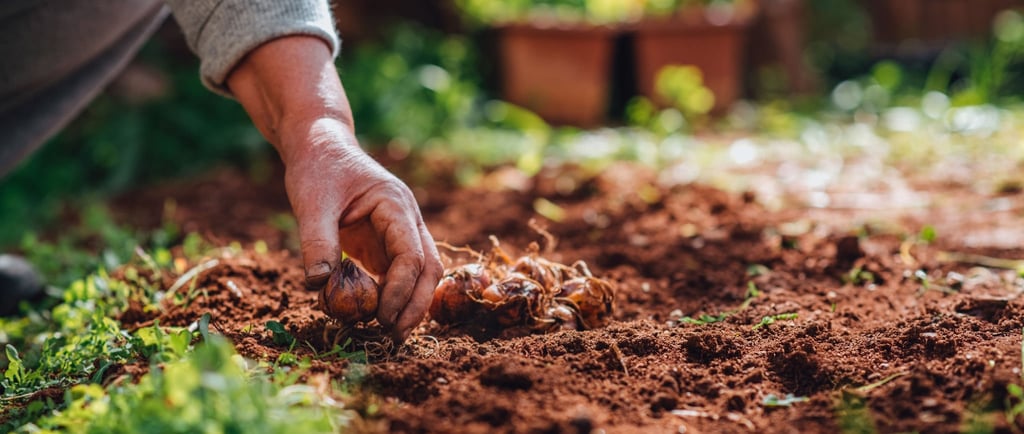Spring’s Hidden Heroes 🦸🏻 The Underground Helpers 🌿
🌱 A story rooted in the Chapter The Stem in the Biology Album. 🌿✨ It reveals the underground world of subterranean stems and their hidden survival strategy - to store food, spread, and endure harsh seasons beneath our feet. 🌸🕳️ From the layered bulbs of tulips to the wandering rhizomes of violets, these stems connect to the greater story of adaptation, competition, and plant resilience. 🍀🌾 Just as aerial stems stretch toward the sun, subterranean stems navigate the dark, unseen world below. How do plants decide whether to grow up or down? And what other secrets do stems hold? 🌍🔍 Let’s dig deeper into their story! 🌱✨
BIOLOGY STORIES
3/7/20253 min read


The days are growing longer, the sun is shining brighter, and something magical is happening all around us. 🌞 Have you noticed the little green shoots pushing up from the ground? 🌱 Have you seen the bright yellow daffodils 🌟, purple crocuses 💜, and cheerful tulips 🌷 decorating gardens and parks? These beautiful spring flowers have been hiding a secret all winter long. ❄️ They were asleep beneath the earth, waiting for the warm sun to wake them up! But how did they survive the cold, dark months? 🤔 They have a part that other plants don’t, and this part they keep hidden beneath everyone. The secret beneath the ground is a very special type of stem!✨
We have found that plants need sunlight, air, and water to grow, but there is a lot of competition above the ground. Some plants have found a clever way to survive—they send their stems below the soil for protection! These special stems are called subterranean stems. That’s a big word! Let’s clap it out: 👏🏻sub-ter-ra-ne-an 👏🏻. It means “underground.”
Plants are like nature’s great inventors, and not all of them use the same kind of underground stem! Some are treasure chests 💰, some are hidden highways 🚇, and others are food factories 🏭 just waiting to surprise us! 🌍 They have come up with different tricks! Let’s meet some of these underground heroes!
💡🌷Meet the bulb ! A bulb is like a tiny treasure chest 💰 full of food. Inside, it stores everything the plant will need to grow in the spring. 🌼 The word bulb comes from the Greek bolbos, meaning ‘onion’ 🧅 ! If we cut an onion in half , snip! ✂️ We can see the layers inside. Those layers are actually leaves full of stored food. 🍃When the time is right, the bulb sends up a green shoot and—ta-da!—a beautiful flower appears!🌸Other plants with bulbs are the tulips and the daffodils! 🌷🌼
And here, I have a corm 👏🏻 meaning ‘tree trunk’ 🌳 It looks a bit like a bulb, but here’s the trick—when we cut it open, it’s solid inside! Like the tree trunk itself! Corms are tough and covered in papery leaves, almost like they’re wearing a jacket! 🧥But how can you tell if a bulb is actually a corm? Try cutting it open—if it has layers like an onion, it’s a bulb! If it’s solid all the way through, you’ve found a corm! The crocus and gladiola use corms to store their food.
Can you guess what kind of underground stem a potato is?🥔 It’s a tu-ber 👏🏻! The name comes from the Latin word tuber, meaning 'a lump' or 'swelling'—which makes sense because tubers are like nature’s little food storage sacks! 🎒 ! Tubers store food underground, and they can make new plants all on their own. 🌱 Have you ever seen tiny shoots growing out of a potato? Those little eyes 👀 are buds that can grow into a whole new potato plant! 🥔✨ If you find some forgotten potatoes somewhere in a dark, warm cubby in the kitchen, you might see them sprouting little green shoots 🌿—nature’s way of saying, “Hey, I’m ready to grow! Plant me!” 🌱👐 And guess what? Some flowers grow from tubers too! 🌸 This beautiful popmpom like flower named dahlia 👏🏻 has a tuberous stem hidden underground, storing energy for its next bloom! 🌺✨
Some plants like to spread out under the soil and send up new shoots along the way. 🌿These underground travelers are called rhizomes . Take a look at 🫚 Ginger 🕵️♂️🌱It looks like a bumpy, twisted root, but it’s actually a rhizome full of stored energy. The word rhizome comes from the Greek word for “root,” but don’t be fooled—rhizomes are really stems in secret underground mode! If you plant a piece of ginger in the soil, it won’t just sit there—it will start spreading sideways, sending up green shoots while growing new rhizomes underground! That’s how ginger keeps expanding and making more of itself. Now remember, when you spot this two flowers Iris , and violet , you know their secret stem - they relay on their rhizomes to grow and spread.
Now that we know about these amazing underground stems, let’s go outside 🏞️ and see what we can find! Look closely at the ground—can you spot new shoots coming up? 🌱 Let’s dig in the soil gently 🏕️ and see if we can find a bulb 🏺, a corm 🌰, a tuber 🥔, or a rhizome 🚇. If you find a forgotten potato in the kitchen, leave it out for a few days and watch what happens! 👀✨
I wonder...🤔 What other plants might have hidden underground stems? 🌾 Is there any edible subterranean stems 🍲 ?
With Montessori joy,
Vanina 😊

